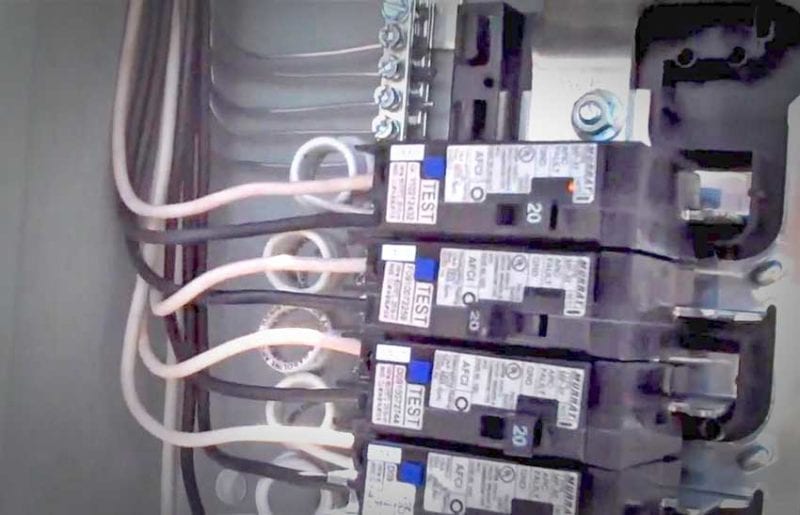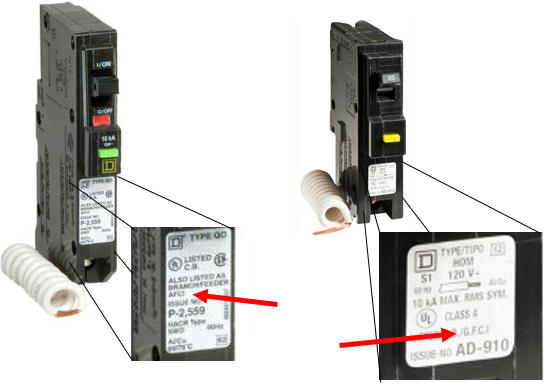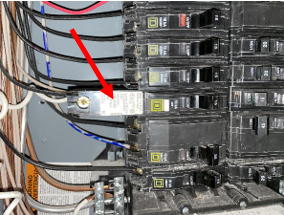Arc Fault Circuit Interrupters (AFCIs)


Since 2002, electrical standards have required a new device called an Arc Fault Circuit Interrupter (or AFCI for short) for bedroom outlets. An "outlet" is any place where electricity is tapped into it. It can be a receptacle, ceiling light, ceiling fan, hardwired smoke detector, etc. The 2008 National Electric Code (NEC) expanded AFCI requirements to include nearly all 120 Volt 15 and 20 Amp circuits in the home, including family rooms, dining rooms, living rooms, parlors, libraries, dens, bedrooms, sunrooms, recreation rooms, closets, hallways, laundry areas and similar rooms and areas. Areas that required Ground Fault Circuit Interrupter (GFCI) protection were not required to be AFCI protected as of the 2008 NEC. That changed with the 2014 NEC which added AFCI protection requirements for branch circuits supplying kitchens and laundry rooms. Pennsylvania is currently using the 2017 NEC.
AFCIs should not be confused with GFCIs. A GFCI is a device that can be in circuit breaker or receptacle form and detects potential electical leakage (a ground fault) that can potentially lead to an electrical shock. GFCIs are required in wet-prone areas including bathrooms, garages, kitchens, unfinished basements, laundry sinks and at the home's exterior.
AFCIs help prevent fires whereas GFCIs help prevent electrical shock. Arc faults and ground faults are two different things.
AFCIs help prevent fires whereas GFCIs help prevent electrical shock. Arc faults and ground faults are two different things.
An arc fault can be thought of as a mini-lightning bolt in a few different scenarios. One of those scenarios can be if a single conductor (wire) is damaged and there is arcing between the breaks in the same wire. This can also be caused by a loose connection at a circuit breaker, receptacle, switch, etc. This is called a series arc.
Another scenario is where multiple adjacent damaged conductors are arcing to each other which is called a parallel arc or a 'line to neutral' arc. Arcing can lead to a very hot situation -- potentially reaching 10,000 degrees Fahrenheit -- which can easily ignite nearby combustibles including appear, insulation, wood, etc. This can lead to a house fire, destroying property and potentially killing people. According to the Consumer Product Safety Commission (CPSC), "Each year in the United States, over 40,000 fires are attributed to home electrical wiring. These fires result in over 350 deaths and over 1,400 injuries each year." Arc faults are one of the major causes of these house fires. This is why AFCI protection is now required in modern homes.

The photo shows melted wire insulation at a receptacle's side wire connections. One of the conductors connected to the receptacle came loose over time and led to series arcing resulting in melted wire insulation.
When wiring is energized, it heats up and expands slightly. The more electricity that flows on the wiring, the more heat and expansion occurs. Sometimes this wire expansion can over time lead to a loose connection since the wire is in essence 'pushing away' from the screw or terminal that originally held the wire in place. This loose connection can then lead to arcing.
If you look at a breaker panel of a home built between 202 and 2010, you will likely see one or a few AFCI breakers. If you look at the breaker panel of a home built after 2010, you will notice many AFCI breakers are installed.
AFCI protection has generally been done with special AFCI circuit breakers although AFCI receptacles are not on the market. AFCI breakers are larger in size than regular non-AFCI and non-GFCI breakers to allow room for the extra electronics inside them and include a test button. GFCI circuit breakers also have a test button incorporated. Different brands of GFCI and AFCI breakers use different colors of test buttons, but all GFCI and AFCI breakers will be clearly labeled "GFCI" or "AFCI" (usually on a little white sticker) or sometimes the abbreviations are actually spelled out on the device instead -- see the stickers on the devices below. Some newer breakers provide GFCI and AFCI protection and are now on the market and called dual-function.

The left side breaker is an AFCI breaker. The right side breaker is a GFCI. Notice that the labels specify their type.

The photo to the left shows an AFCI circuit breaker installed alongside regular circuit breakers. Notice the difference in size of the AFCI breaker.
AFCI breakers and receptacles have special electronics built into them which monitors the sine waves of the electricity's current and voltage. Excessive arcing disrupts these normal sine waves which can trigger the AFCI to jump into action ("trips") and shut off the offending circuit. Regular circuit breakers protect only against overloads and short circuits whereas AFCI breakers protect against overloads, short circuits and arc faults. Motors in the home, such as in a vacuum cleaner, will present arcs on their branch circuit as well. However, AFCI devices are designed to be able to differentiate between normal arcs and potentially dangerous arcs.
Think of hanging a picture on a wall. You hammer in a nail and unbeknownst to you the nail accidentally pierces wiring inside the wall. Whether it's a series or parallel arc, if the circuit is AFCI protected, the AFCI device should sense the abnormal arc and cause the AFCI device to trip. Besides the example above using a nail into wiring within a wall, some other examples of how wiring can be damaged include an appliance cord improperly run under furniture or carpet, wiring that is susceptible to mechanical movement or wear, etc.
The early versions of AFCI breakers also provided some GFCI protection but it was at a higher tripping-threshold (30-50 mA) than what electrical standards require for GFCI protection (5 mA). Dual-function AFCI breakers are designed to provide GFCI protection at this lower tripping-threshold meaning dual-function AFCI breakers can provide AFCI and GFCI protection in one device.
There are three different types of AFCI devices:
- Branch Circuit Feeder AFCI Breaker -- basic AFCI breaker that detected only parallel arcing (between hot and neutral wires). These were the basic type dating back to 2002 when AFCIs were first introduced into electrical standards.
- Combination Breaker AFCI -- an upgrade of the branch circuit feeder AFCI breaker that also provided series arc protection. This sort of protection can help detect arcs in things like damaged appliance cords plugged into an AFCI-protected circuit.
- Dual-Function AFCI/GFCI Protection -- these are the type of modern AFCI devices that provide AFCI (series and parallel arcing) and GFCI protection. This technology provides the best of both types of protection . . . safety from things that can lead to electrical shock or fire.
In the photos above, you'll notice the little white pig-tailed wiring on the breakers. This white wire is the neutral conductor connection for the device to the breaker panel's grounded terminal bar. One brand, Square D, is now selling a new model of panel and AFCI breaker that no longer requires the pig-tail but instead the AFCI breaker's neutral side is designed to connect directly to the breaker panel's grounding bar.
So the next question may be about the AFCI's test button. The only recognized way to test an AFCI breaker or AFCI receptacle is to use the device's built-in "TEST" button instead of a plug-in tester. GFCI devices should also be tested using their "TEST" buttons. When performing a home inspection, inspectors do not test AFCIs in occupied homes as doing so will shut the power off to the affected circuits. This could include a computer or something else running that the inspector doesn't know about.
If there is AFCI protection installed but it was not tested, the inspector should note that in the report and note why they were not tested (such as 'the home was occupied'). In vacant homes, however, we do test AFCIs using their test buttons. Then we go back through the home to make sure there is no power at the receptacles, light fixtures, ceiling fans and hardwired smoke detectors in the areas where AFCI protection is required. Once this has been confirmed, we will reset the AFCI devices to re-energize those circuits. An issues that I sometimes find in homes built between 2002 and 2009 are hardwired smoke detectors not being AFCI protected. If the AFCI is tripped and the bedrooms' smoke detectors are still powered by the home (normally showing a green LED), these circuits are not AFCI protected as required. Modern hardwired smoke detectors have a battery backup so they are powered even if a regular or AFCI circuit breaker is tripped. From when AFCI protection was initially required for bedroom circuits (2002), hardwired smoke detectors in bedroom have been required to be AFCI protected.
Even if your home predates these modern electrical standards, AFCI breakers may be able to be installed in older breaker panels to provide extra protection for your home. AFCI breakers generally run between $30-$50 each and a qualified electrician can determine if AFCI breakers are available for the brand type of panel installed in your home and what the total cost would be. AFCI receptacles, however, can be added in older homes regardless of the type of breaker panel installed. When installed as the first outlet on a branch circuit, AFCI receptacles provide series and parallel arc protection for outlets downstream but will not protect the wiring between the first AFCI receptacle and the breaker panel, however. Overall an AFCI circuit breaker provides more protection than an AFCI receptacle. Only a qualified electrician should install AFCI circuit breakers or receptacles.
Nearby lightning strikes and some appliances were prone to cause nuisance tripping of some older AFCI (and GFCI) devices. Newer technologies make the nuisance tripping much less of an issue nowadays.
Facts, opinions and information expressed in the Blog represent the work of the author and are believed to be accurate, but are not guaranteed. The Lancaster County Association of Realtors is not liable for any potential errors, omissions or outdated information. If errors are noted within a post, please notify the Association. Posts represent the author's opinion and are not necessarily the opinion of the Association.













